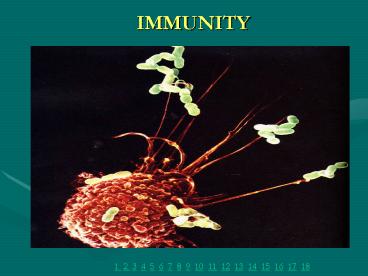IMMUNITY - PowerPoint PPT Presentation
1 / 18
Title:
IMMUNITY
Description:
Define antibody, antigen, cell-mediated immune response and humoral immune response ... a) Cell-mediated immune response. b) Humoral immune response ... – PowerPoint PPT presentation
Number of Views:28
Avg rating:3.0/5.0
Title: IMMUNITY
1
IMMUNITY
1 2 3 4 5 6 7 8 9 10 11 12 13 14 15
16 17 18
2
Chapter Outlines
- Define antibody, antigen, cell-mediated immune
response and humoral immune response - Describe lymph structure and its function
- Explain detail cell-mediated immune response and
humoral immune response - Explain self and non-self recognition , autoimun
concept and its application in medicine - Describe and explain AIDS, causative agent,
symptoms, prevention, mechanism of HIV infection
and replication of HIV.
1 2 3 4 5 6 7 8 9 10 11 12 13 14 15
16 17 18
3
11.1 Immune response
- By the end of the lesson, students should be able
- to
- describe immunity
- describe the roles of lymphoid organs in immunity
- describe the structure of antibody and state the
classes of antibodies
1 2 3 4 5 6 7 8 9 10 11 12 13 14 15
16 17 18
4
Key terms
- Pathogens Disease-causing microorganism,
including certain viruses, bacteria, fungi and
protozoa - Immune response recognition of foreign
macromolecules and response aimed at eliminating
them - Antigen any molecule that can be specifically
recognized as foreign by cell of the immune
system - Antibodies highly specific protein that
recognized and bind to specific antigens
1 2 3 4 5 6 7 8 9 10 11 12 13 14 15
16 17 18
5
An overview of the bodys defenses
1 2 3 4 5 6 7 8 9 10 11 12 13 14 15
16 17 18
6
The Human Immune System
- Two types of defensive mechanism
- 1) Non-specific
- protection by skin, mucous and acidic at
stomach - 2) Specific
- a) Cell-mediated immune response
- b) Humoral immune response
1 2 3 4 5 6 7 8 9 10 11 12 13 14 15
16 17 18
7
Immunity
- Organism defence system in response to foreign
or potential dangerous substances (antigen) - Type of immunity
- 1) Pasive immunity
- - induced by injection of serum taken from
an individual already immune to particular
antigen - - transfer the maternal antibodies via placenta
or breast milk. - 2) Active immunity
- -arises when the body produces antibodies
against an invading foreign substances
1 2 3 4 5 6 7 8 9 10 11 12 13 14 15
16 17 18
8
- Immunity can defined by
- - infection by foreign substances
- - the state of relative insusceptibility of an
animal to infection by
disease-producing organism or to the harmful
effects of their poisons (toxins). - Immune response the reaction of the body to
foreign or potentially dangerous substances
(antigen).
1 2 3 4 5 6 7 8 9 10 11 12 13 14 15
16 17 18
9
Definition
- Antigen
- immunogen
- Any substances capable of stimulating an
immune response, usually a protein or a
large carbohydrate that is foreign to the body.
1 2 3 4 5 6 7 8 9 10 11 12 13 14 15
16 17 18
10
Antibody
- immunoglobulin
- Protein compounds produced by plasma cells in
response to specific antigens and having the
capacity to react against the antigens - Two functions of antibody
- merge with antigen
- activate process of destroy antigen by
phagocytosis
1 2 3 4 5 6 7 8 9 10 11 12 13 14 15
16 17 18
11
1 2 3 4 5 6 7 8 9 10 11 12 13 14 15
16 17 18
12
What is an Antigen?
- An antigen is any molecule or structure
- that is could trigger the immune response system
- A lymphocyte actually recognizes and binds
- to just a small, accessible portion of the
antigen called an epitope
1 2 3 4 5 6 7 8 9 10 11 12 13 14 15
16 17 18
13
What are Antibodies?
- Proteins produced by plasma cells (B lymphocytes)
that recognize foreign antigens and prevent them
from causing disease.
1 2 3 4 5 6 7 8 9 10 11 12 13 14 15
16 17 18
14
Antibody Structure
- Each antibody consists of 4 polypetide chains
- two short polypeptides, light chains,
- two identical long chains, heavy chains.
- Antibodies with the same variable segments have
identical clefts - therefore recognize the same antigen.
- The 4 polypeptide chains are held together by
covalent disulfide (-S-S-) bonds.
1 2 3 4 5 6 7 8 9 10 11 12 13 14 15
16 17 18
15
Antibody Structure Function
Attachment of an antibody Now marks the
invader for ingestion by phagocytotic cells
(eg. WBC)
The antigen binding site is specific to the
protein coat of a given bacteria or virus
(species specific).
1 2 3 4 5 6 7 8 9 10 11 12 13 14 15
16 17 18
16
Antibody Structure
1 2 3 4 5 6 7 8 9 10 11 12 13 14 15
16 17 18
17
Immunoglobulin Classes
- Based on differences in structure of constant
regions on heavy chains, antibody can be divided
into 5 classes - IgM
- IgG
- IgA
- IgD
- IgE
1 2 3 4 5 6 7 8 9 10 11 12 13 14 15
16 17 18
18
1 2 3 4 5 6 7 8 9 10 11 12 13 14 15
16 17 18































